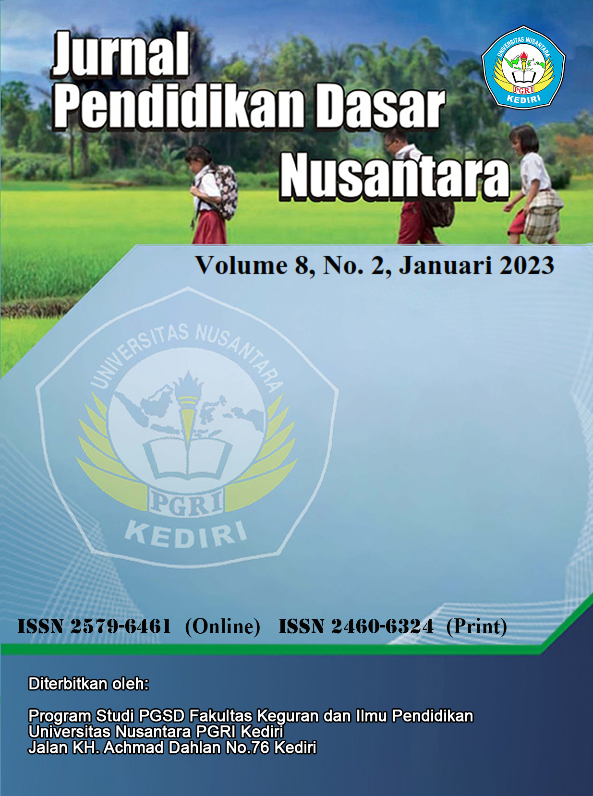Analysis of suitability of material aspects in articulate storylane based solution colligative learning media for PGSD students
DOI:
https://doi.org/10.29407/jpdn.v8i2.19524Keywords:
Material, Competence, Articulate StorylineAbstract
This study aims to determine the suitability of colligative material aspects of the solution in articulate storyline-based learning media with assessment indicators on aspects of suitability of material with Basic Competency, suitability of material concepts with media, contextuality, depth of material, ease of material to understand, systematics, clarity of material, suitability of amount practice questions with the amount of material presented, the ease of reviewing the material, motivating students as a whole. The research instrument was a questionnaire assessment sheet related to the suitability of the material with the Basic Competency in articulate storyline-based learning media based on the aspects that have been mentioned. The method used in this study is the one method, which is a research step using a qualitative approach. The results of the research on the suitability analysis of colligative material solutions on articulate storyline-based learning media were obtained from a validity questionnaire questionnaire by two material experts. The suitability of the material aspects of this media is the result of validator one giving an average score with a percentage score of 88% including very good criteria (very valid), and validator two giving a percentage of an average score of 82%, namely in the good category ( valid). So it can be concluded that the suitability of the material aspects of the articulate storyline-based learning media is stated to be appropriate and valid
Downloads
References
Angela, T. (2014). Challenges to Meaningful Learning in Social Studies – The Key Competences as an Opportunity to Students’ Active Participation. Procedia - Social and Behavioral Sciences, 128, 192–197. https://doi.org/10.1016/j.sbspro.2014.03.142.
Auliyani, A., Hanum, L., & Khaldun, I. (2018). Analisis Kesulitan Pemahaman Siswa pada Materi Sifat Koligatif Larutan dengan Menggunakan Three-Tier Multiple Choice Diagnostic test di Kelas XII IPA 2 SMA Negeri 5 Banda Aceh. Jurnal Ilmiah Mahasiswa Pendidikan Kimia, 2(1), 55–64.
Arda, Saehana, S., & Darsikin. (2015). Pengembangan Media Pembelajaran Interaktif Berbasis Komputer Untuk Siswa Smp Kelas Viii. E-Jurnal Mitra Sains, 3(1), 69–77.https://media.neliti.com/media/publications/153834-ID-pengembangan-media pembelajaran-interakt.pdf.
Arikunto S. (2009). Metodologi Penelitian. Journal of metodology, 96
Fardila, S., & Arief, M. (2021). Pengembangan mobile learning berbasis articulate storyline 3 pada mata pelajaran kearsipan untuk meningkatkan self regulated learning dan hasil belajar siswa (studi pada kelas x OTKP di SMK Cendika Bangsa Kepanjen). Jurnal Ekonomi, Bisnis dan Pendidikan, 1(4), 344–356.
Juhaeni, J., Safaruddin, S., & Salsabila, Z. P. (2021). Articulate Storyline Sebagai Media Pembelajaran Interaktif Untuk Peserta Didik Madrasah Ibtidaiyah. AULADUNA: Jurnal Pendidikan Dasar Islam, 8(2), 150.
Gurung, R. A. R. (2020). Call It Out: Recognizing Good Teaching and Learning. Journal of Applied Research in Memory and Cognition, 9(2), 161–164. https://doi.org/10.1016/j.jarmac.2020.02.003.
Hanum, Inayah. 2015. Pengembangan Bahan Ajar. Medan: Medan Press.
Hartog, F. (1967). Analisis Kesesuaian Antara Materi, Metode Dan Media Pembelajaran Pada Mata Pelajaran Pai Di Kelas V Sdn 2 Bapinang Hilir Laut. Angewandte Chemie International Edition, 6(11), 951–952., 5–24.
Najmah, N., Khaeruman, K., & Khery, Y. (2014). Korelasi Antara Keterampilan Proses Sains Dengan Hasil Belajar Mahasiswa Pada Praktikum Sifat Koligatif Larutan. Hydrogen: Jurnal Kependidikan Kimia, 2(2), 17.
Nasution, A. S., & Umar, A. (2018). Analisis Kesesuaian Materi Pada Buku Teks Bahasa Indonesia Dengan Kompetensi Dasar Pada Silabus Bahasa Indonesia Kelas Vii Smp Kurikulum 2013 (Edisi Revisi). Kode: Jurnal Bahasa, 7(2).
Oliver, J. (2019). Jenis Metode Penelitian Dan Tata Cara Penulisan. Hilos Tensados, 1(1), 1–476
Rafmana, H., & Chotimah, U. (2018). Pengembangan Multimedia Interaktif Berbasis Articulate Storyline Untuk Meningkatkan Motivasi Belajar Siswa Pada Mata Pelajaran PKn Kelas XI Di SMA Srijaya Negara Palembang. Jurnal Bhinneka Tunggal Ika, 05(1), 52–65.https://ejournal.unsri.ac.id/indeks.php/jbti/article/download/7898/pdf.
Rahmat, R. F., Mursyida, L., Rizal, F., Krismadinata, K., & Yunus, Y. (2019). Pengembangan media pembelajaran berbasis mobile learning pada mata pelajaran simulasi digital. Jurnal Inovasi Teknologi Pendidikan, 6(2), 116–126.
Rodrigo Garcia Motta, Angélica Link, Viviane Aparecida Bussolaro, G. de N. J., Palmeira, G., Riet-Correa, F., Moojen, V., Roehe, P. M., Weiblen, R., Batista, J. S., et al. (2021). Title. Pesquisa Veterinaria Brasileira (Vol. 26). Retrieved from http://www.ufrgs.br/actavet/31-1/artigo552.pdf.
Safriandono, A. N., & Charis, M. (2014). Rancang Bangun E-Lembar Kerja Siswa sebagai Media Pembelajaran yang Praktis, Fleksibel dan Edukatif Berbasis Web. Jurnal Teknik-UNISFAT, 10(1), 25–35.
Sari, R. K., & Harjono, N. (2021). Pengembangan Media Pembelajaran Interaktif Berbasis Articulate Storyline Tematik Terhadap Minat Belajar Siswa Kelas 4 SD. Jurnal Pedagogi dan Pembelajaran, 4(1), 122.
Setyaningsih, S., Rusijono, R., & Wahyudi, A. (2020). Pengaruh Penggunaan Media Pembelajaran Interaktif Berbasis Articulate Storyline Terhadap Motivasi Belajar dan Hasil Belajar Siswa Pada Materi Kerajaan Hindu Budha di Indonesia. Didaktis: Jurnal Pendidikan dan Ilmu Pengetahuan, 20(2), 144–156
Tafonao, T. (2018). Peranan Media Pembelajaran Dalam Meningkatkan Minat Belajar Mahasiswa. Jurnal Komunikasi Pendidikan, 2(2), 103. https://doi.org/10.32585/jkp.v2i2.113.
Yumini, S., & Rakhmawati, L. (2015). Pengembangan Media Pembelajaran Interaktif Berbasis Articulate Storyline Pada Mata Diklat Teknik Elektronika Dasar Di Smk Negeri 1 Jetis Mojokerto. Jurnal Pendidikan Teknik Elektro, 4(3), 845–849.https://jurnalmahasiswa.unesa.ac.id/index.php/jurnal-pendidikan-teknikelektro/article/view/1267.
Downloads
Published
Issue
Section
License
Authors who publish with this journal agree to the following terms:
- Copyright on any article is retained by the author(s).
- The author grants the journal, the right of first publication with the work simultaneously licensed under a Creative Commons Attribution License that allows others to share the work with an acknowledgment of the work’s authorship and initial publication in this journal.
- Authors are able to enter into separate, additional contractual arrangements for the non-exclusive distribution of the journal’s published version of the work (e.g., post it to an institutional repository or publish it in a book), with an acknowledgment of its initial publication in this journal.
- Authors are permitted and encouraged to post their work online (e.g., in institutional repositories or on their website) prior to and during the submission process, as it can lead to productive exchanges, as well as earlier and greater citation of published work.
- The article and any associated published material is distributed under the Creative Commons Attribution-ShareAlike 4.0 International License

































